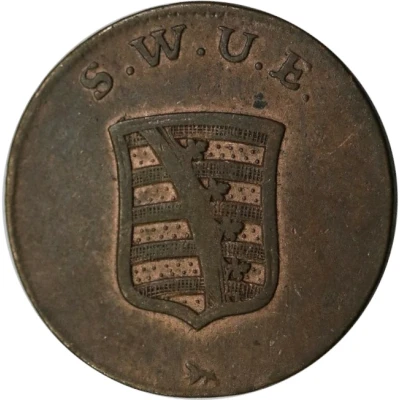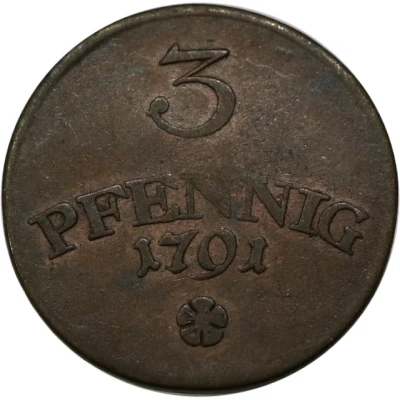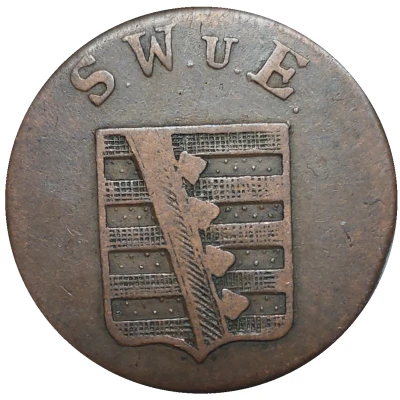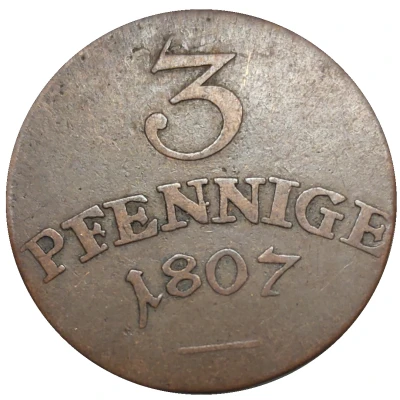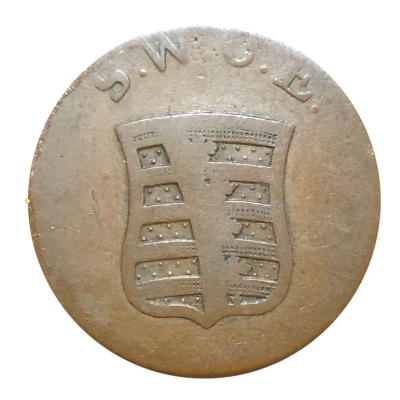
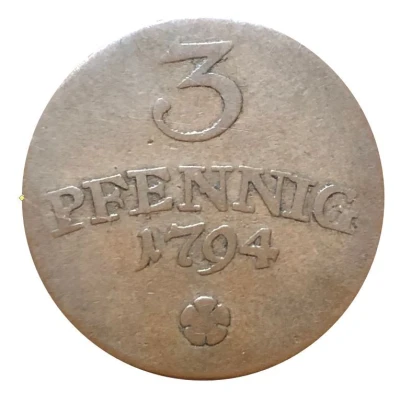

© Rhonan (CC BY-NC-SA)
3 Pfennigs - Charles August
| Copper | 7.6 g | 26 mm |
| Issuer | Duchy of Saxe-Weimar-Eisenach (Saxe-Weimar-Eisenach, German States) |
|---|---|
| Duke | Charles Augustus (Karl August) (1758-1815) |
| Type | Standard circulation coin |
| Years | 1792-1794 |
| Value | 3 Pfennigs (3 Pfennige) |
| Currency | Thaler (1741-1870) |
| Composition | Copper |
| Weight | 7.6 g |
| Diameter | 26 mm |
| Thickness | 1.0 mm |
| Shape | Round |
| Orientation | Medal alignment ↑↑ |
| Demonetized | Yes |
| Updated | 2024-10-05 |
| Numista | N#74355 |
|---|---|
| Rarity index | 82% |
Reverse
Curved 3 line inscription with date, rosette below.
Script: Latin
Lettering: 3 // Pfennig // 1794 // *
Edge
Reeded
Comment
Ref. K-611. Prev. C#59b.Saxe-Weimar-Eisenach (German: Sachsen-Weimar-Eisenach) was created as a duchy in 1809 by the merger of the Ernestine duchies of Saxe-Weimar and Saxe-Eisenach, which had been in personal union since 1741. It was raised to a grand duchy in 1815 by resolution of the Vienna Congress. In 1903, it officially changed its name to the Grand Duchy of Saxony (German: Großherzogtum Sachsen), but this name was rarely used. The Grand Duchy came to an end in the German Revolution of 1918–19 with the other monarchies of the German Empire. It was succeeded by the Free State of Saxe-Weimar-Eisenach, which was merged into the new state of Thuringia two years later.
The full grand ducal style was Grand Duke of Saxe-Weimar-Eisenach, Landgrave in Thuringia, Margrave of Meissen, Princely Count of Henneberg, Lord of Blankenhayn, Neustadt and Tautenburg.
The Saxe-Weimar-Eisenach branch has been the most genealogically senior extant branch of the House of Wettin since 1672.
Interesting fact
One interesting fact about the Standard circulation coin 3 Pfennigs - Charles August 1792-1794 from Duchy of Saxe-Weimar-Eisenach (Saxe-Weimar-Eisenach, German States) made of Copper weighing 7.6 g is that it was minted during a time of great economic and political change in Germany. The coin was issued during the reign of Charles August, who was the Duke of Saxe-Weimar-Eisenach from 1758 to 1809. During his reign, Charles August implemented a number of reforms aimed at modernizing the economy and government of the duchy, including the introduction of a new currency system. The 3 Pfennigs coin was part of this new currency system and was used widely in everyday transactions. Despite its small denomination, the coin is a valuable piece of history and a reminder of the economic and political changes that took place in Germany during the late 18th and early 19th centuries.
